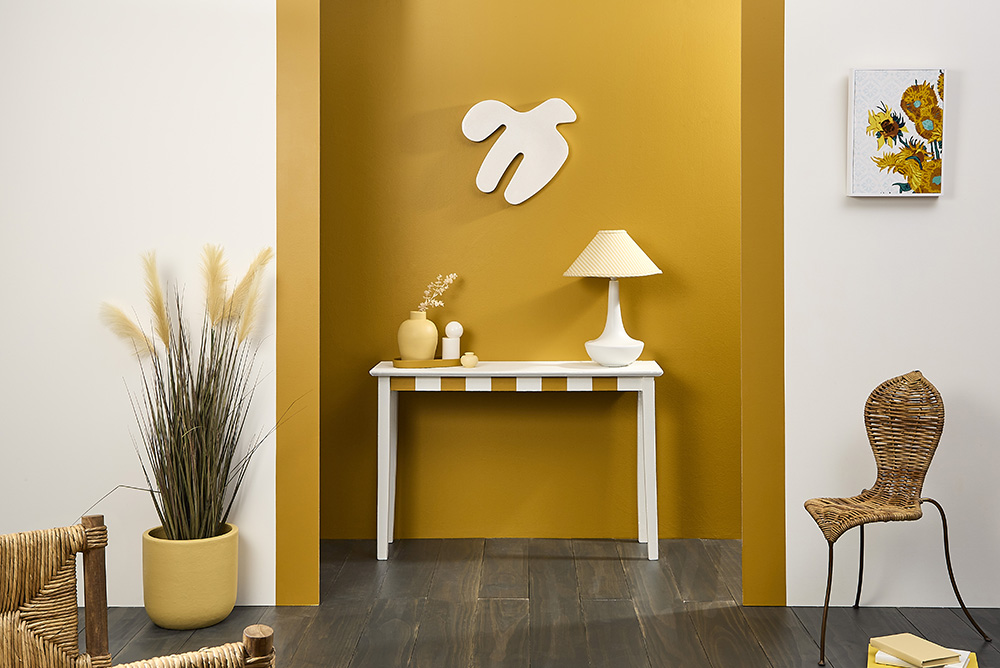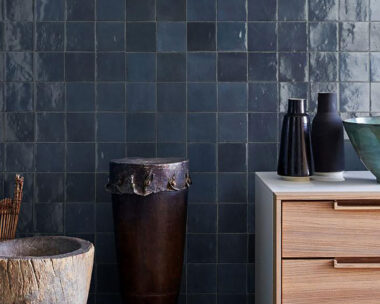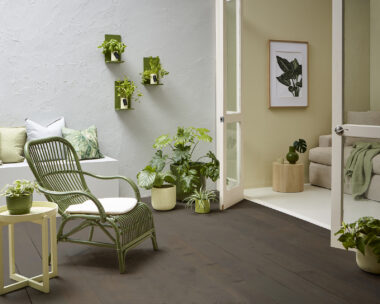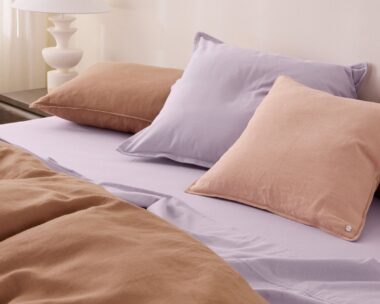Liek fashion, interior trends tend to repeat themselves every 30 years or so which is why we’re all currently loving some great interior and colour trends that emerged in the 1990s. This means we’re taking a fresh look at things like minimalism, textured effects, feature walls, bold bursts of colour, pretty florals and touches of grunge in a fondness for raw materials and deconstructed finishes.
Resene Colour Expert Madison McLeod says adapting ’90s trends for a fresh and modern look is often about simplifying and personalising them.
“The ’90s were all about colour and patterns, with every room having to have a feature finish to it. That approach is certainly on the rise again today, but in a more controlled, considered manner.

Modern shapes and visual texture update traditional 90s minimalism. Left back wall painted in Resene Parchment with feature wall painted in Resene Parchment and Resene Foundry. Project by Vanessa Nouwens, image by Bryce Carleton.
How do you use colours and patterns for a feature wall?
Feature walls were a big trend in the ’90s and even into the early 2000s as people realised they not only added instant impact to a room, but they were a great way to experiment with colour without over-committing or spending a lot of money. The same is true today as we increasingly want to play with colours and patterns to make our interiors reflect our personalities.
“In the 90s we saw a lot of feature walls in bright, bold colours,” Madison says. “This is popular in homes today, but instead of just one wall, try wrapping the colour around two sides to balance out the room.”
She also suggests trying colours that are ‘greyed off’ or more muted, particularly if you’re nervous about getting too bold. “Think calming greens and blues that verge on being a neutral tone, like the complex grey-green of Resene Tana, Resene Double Linen or Resene Unite.”
If you want to use a brighter paint finish, like a Resene Scoria or Resene Deep Teal, Madison suggests adding visual or physical texture to the surface to help diffuse the intensity of the colour. One of the simplest ways to do this is to use Resene Anaglytpa wallpaper and paint over it in your chosen Resene colour. These wallpapers have a raised pattern on them, that will give your feature wall and colour interesting depth.

Feature walls are the perfect way to add a punch of dramatic colour to an otherwise neutral palette. These side walls are painted in Resene Orchid White, with the rear wall and frame in Resene Hot Toddy. Project by Melle Van Sambeek, image by Bryce Carleton.
How do you create a textured feature wall?
Resene FX Paint Effects Medium can also help you replicate a number of different visual textured looks from sponging, rag-rolling or a weathered brushstroke look. For most projects, to get the look you want, you’ll need a base colour and at least one other shade mixed with Resene FX Paint Effects Medium to break up the colour slightly and give it that purposely sheer or broken look.
Top tip: Always experiment with Resene FX Paint Effects Medium on a piece of wood or board before you commit to your wall, trying different colour combinations and adjusting how much paint you mix with the medium. Talk to your local Resene ColorShop staff about the look you want to achieve for advice on ratios and colours to try.
You can also add texture with Resene Sandtex which gives you a finish resembling plastered surfaces, perfect if you want a limewashed or beaten earth effect.

Textured walls in warm earthy colours have made a comeback from the 90s. Walls painted in Resene Salted Caramel with Resene Athena mixed with Resene FX Paint Effects Medium. Project by Melle Van Sambeek, image by Bryce Carleton.
Visit your local Resene ColorShop for all the quality paints, wallpapers and colours you need for your project. If you need more helping choosing just the right colours for your place, book in a colour consultation with a Resene Colour Expert, virtually, instore or at your place. Simply visit here to book. Or use the free Resene Ask a Colour Expert service.




